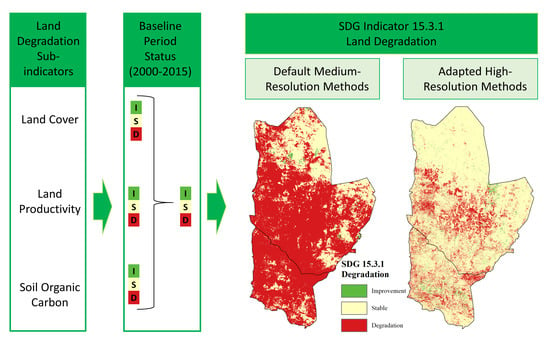Assessment of Land Degradation in Semiarid Tanzania—Using Multiscale Remote Sensing Datasets to Support Sustainable Development Goal 15.3
Abstract
1. Introduction
- How much land is degraded, and where are the hotspots of LD in KK?
- How do the individual sub-indicators affect LD?
- Does using higher resolution data (30 m) improve the delineation of LD compared to moderate-resolution data (250 m)?
2. Materials and Methods
2.1. Study Area
2.2. Materials
| LDN Sub-Indicators | Method | Data | Resolution/Year | Reference |
|---|---|---|---|---|
| Land Cover | Default Method (DM) | ESA-CCI | 300 m (2000–2015) | [36] |
| Adapted Method (AM) | RCMRD | 30 m (2000–2018) | [37] | |
| Land Productivity | DM | MOD-13Q1-coll6 | 250 m (2000–2015) | [38] |
| AM | Landsat 5 | 30 m (2000–2013) | [39] | |
| Landsat 7 | 30 m (2000–2019) | |||
| Landsat 8 | 30 m (2013–2019) | |||
| DM/AM | CHIRPS | 0.05 arc° (2000–2019) | [40] | |
| Soil Organic Carbon | DM/AM | SoilGrids250m | 250 m | [41] |
2.3. Methods
2.3.1. Sub-Indicator 1: Land Cover Transitions and Degradation
2.3.2. Sub-Indicator 2: Loss of Land Productivity
2.3.3. Sub-Indicator 3: Degradation of Soil Organic Carbon
3. Results
3.1. Sub-Indicator 1: Land Cover Transitions and Degradation
3.2. Sub-Indicator 2: Loss of Land Productivity
3.3. Sub-Indicator 3: Degradation of Soil Organic Carbon
3.4. Combined Sustainable Development Indicator 15.3.1 for the Baseline and First Monitoring Period
3.5. Combined Sustainable Development Indicator 15.3.1 over 20 Years Using the AM
4. Discussion
5. Conclusions
Author Contributions
Funding
Data Availability Statement
Acknowledgments
Conflicts of Interest
Appendix A
| DM Land Cover Category in 2015 (km2) | ||||||||
|---|---|---|---|---|---|---|---|---|
| Forestland | Grassland | Cropland | Wetland | Urban | Otherland | 2000 Total (km2) | ||
| DM Land cover category in 2000 (km2) | Forestland | Stable 2810.18 | Vegetation loss 3,83 | Deforestation 0.68 | Inundation 0 | Deforestation 0.49 | Vegetation loss 0 | 2815.19 |
| Grassland | Afforestation 127.43 | Stable 6976.03 | Agricultural expansion 18.72 | Inundation 0.74 | Urban expansion 0 | Vegetation loss 0 | 7122.92 | |
| Cropland | Afforestation 3.09 | Withdrawal of agriculture 4.2 | Stable 6606.86 | Inundation 0 | Urban expansion 0.25 | Vegetation loss 0 | 6614.40 | |
| Wetland | Woody encroachment 0 | Waterbody drainage 0 | Waterbody drainage 0 | Stable 537.22 | Waterbody drainage 0.12 | Waterbody drainage 0 | 537.34 | |
| Urban | Afforestation 0 | Vegetation establishment 0 | Agricultural expansion 0 | Wetland establishment 0 | Stable 1.54 | Withdrawal of settlements 0 | 1.54 | |
| Otherland | Afforestation 0 | Vegetation establishment 0 | Agricultural expansion 0 | Wetland establishment 0 | Urban expansion 0 | Stable 0 | 0 | |
| 2015 total (km2) | 2940.71 | 6984.06 | 6626.25 | 537.96 | 2.41 | 0 | 17,091.40 | |
| AM Land Cover Category in 2018 (km2) | ||||||||
|---|---|---|---|---|---|---|---|---|
| Forestland | Grassland | Cropland | Wetland | Urban | Otherland | 2015 Total (km2) | ||
| AM Land cover category in 2015 (km2) | Forestland | Stable 1819.5 | Vegetation loss 89.5 | Deforestation 94.2 | Inundation 19.3 | Deforestation 5.4 | Vegetation loss 13.1 | 2041 |
| Grassland | Afforestation 26.2 | Stable 6993 | Agricultural expansion 368.1 | Inundation 77 | Urban expansion 22.7 | Vegetation loss 77 | 7563.9 | |
| Cropland | Afforestation 9.3 | Withdrawal of agriculture 175.4 | Stable 4602.4 | Inundation 50.9 | Urban expansion 23 | Vegetation loss 64.6 | 4925.6 | |
| Wetland | Woody encroachment 0.7 | Waterbody drainage 5.5 | Waterbody drainage 7.4 | Stable 173.7 | Waterbody drainage 0.8 | Waterbody drainage 4.7 | 192.9 | |
| Urban | Afforestation 0.1 | Vegetation establishment 2.2 | Agricultural expansion 10 | Wetland establishment 0.6 | Stable 196.7 | Withdrawal of settlements 1.4 | 211 | |
| Otherland | Afforestation 2.7 | Vegetation establishment 55.7 | Agricultural expansion 69.7 | Wetland establishment 30.6 | Urban expansion 10.1 | Stable 1988.3 | 2157 | |
| 2018 total (km2) | 1858.4 | 7321.4 | 5151.7 | 352.2 | 258.7 | 2149.1 | 17,091.4 | |
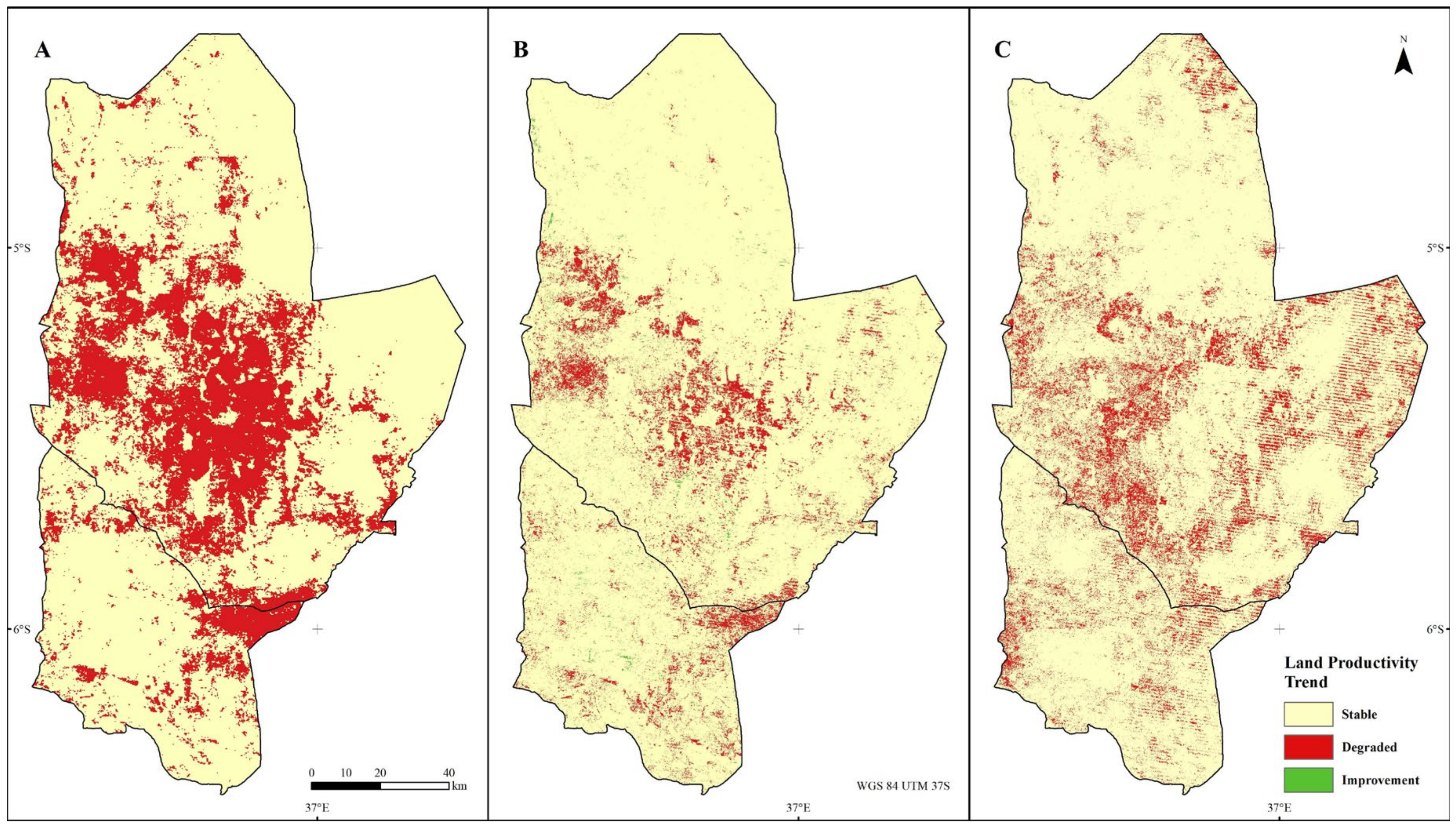

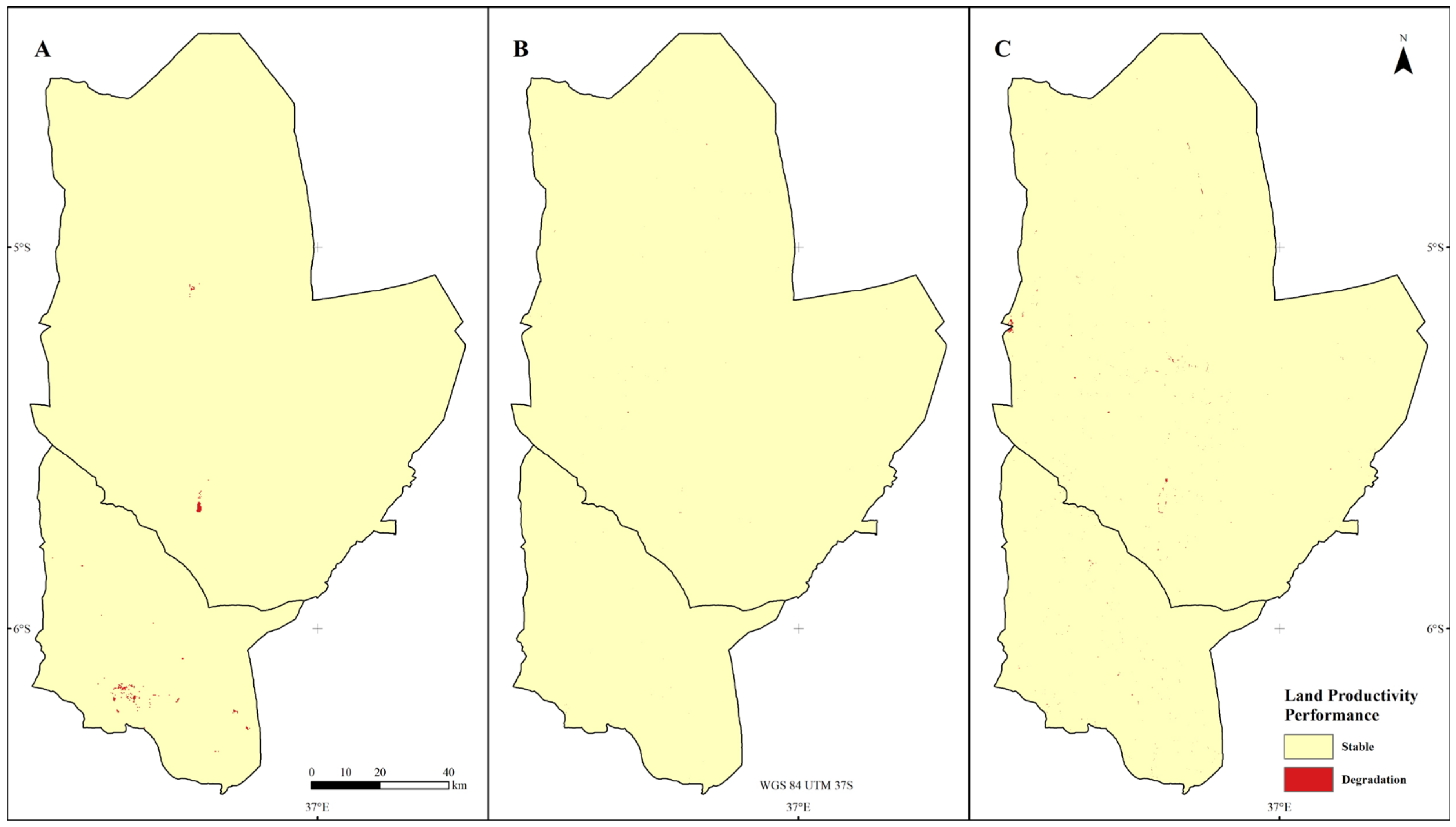
References
- UNCCD. Elaboration of an International Convention to Combat Desertification in Countries Experiencing Serious Drought and/or Desertification, Particularly in Africa; UNCCD: Paris, France, 1994. [Google Scholar]
- Le, Q.B.; Nkonya, E.; Mirzabaev, A. Biomass productivity-based mapping of global land degradation hotspots. In Economics of Land Degradation and Improvement; Nkonya, E., Mirzabaev, A., von Braun, J., Eds.; Springer Open: Cham, Switzerland, 2016; Volume 24, pp. 55–84. ISBN 978-3-319-19167-6. [Google Scholar]
- Bai, Z.; Dent, D.L.; Olsson, L.; Schaepman, M.E. Proxy Global Assessment of Land Degradation. Soil Use Manag. 2008, 24, 223–234. [Google Scholar] [CrossRef]
- Dubovyk, O. The Role of Remote Sensing in Land Degradation Assessments: Opportunities and Challenges. Eur. J. Remote Sens. 2017, 50, 601–613. [Google Scholar] [CrossRef]
- Barbier, E.B.; Hochard, J.P. Land Degradation and Poverty. Nat. Sustain. 2018, 1, 623–631. [Google Scholar] [CrossRef]
- IPBES. The IPBES Assessment Report on Land Degradation and Restoration; 2018. Bonn: Intergovernmental Science-Policy Platform on Biodiversity and Ecosystem Services (IPBES). Available online: https://www.ipbes.net/assessment-reports/ldr (accessed on 24 April 2021).
- ELD Initiative. The Value of Land: Prosperous Lands and Positive Rewards through Sustainable Land Management; Stewart, N., Ed.; Economics of Land Degradation Initiative: Bonn, Germany, 2015; ISBN 978-92-808-6061-0. [Google Scholar]
- IPCC Climate Change and Land. IPCC Special Report on Climate Change, Desertification, Land Degradation, Sustainable Land Management, Food Security, and Greenhouse Gas Fluxes in Terrestrial Ecosystems; IPCC: Geneve, Switzerland, 2019. [Google Scholar]
- UNCCD Report of the Conference of the Parties on Its Seventeenth Session, Held in Durban from 28 November to 11 December 2011: Part Two: Action Taken by the Conference of the Parties at Its Eleventh Session: ICCD/COP(11)/23/Add.1. 2013. Available online: https://unfccc.int/resource/docs/2011/cop17/eng/09.pdf (accessed on 24 April 2021).
- UN Transforming Our World: The 2030 Agenda for Sustainable Development; 2015. Available online: https://stg-wedocs.unep.org/bitstream/handle/20.500.11822/11125/unepswiosm1inf7sdg.pdf?sequence=1 (accessed on 24 April 2021).
- Kirui, O.K.; Mirzabaev, A.; von Braun, J. Assessment of Land Degradation ‘on the Ground’ and from ‘Above’. SN Appl. Sci. 2021, 3, 318. [Google Scholar] [CrossRef]
- FAO The Global Forest Resources Assessment 2015: Desk Reference; Food and Agriculture Organization of the United Nations: Rome, Italy, 2015.
- Kirui, O.K. Economics of land degradation and improvement in tanzania and malawi. In Economics of Land Degradation and Improvement; Nkonya, E., Mirzabaev, A., von Braun, J., Eds.; Springer Open: Cham, Switzerland, 2016; Volume 22, pp. 609–649. ISBN 978-3-319-19167-6. [Google Scholar]
- FAO. NBS Tanzania: CountrySTAT; Food and Agriculture Organization of the United Nations: Rome, Italy; National Bureau of Statistics: Dar es Salam, Tanzania, 2020. Available online: http://tanzania.countrystat.org/home/en/ (accessed on 24 April 2021).
- NBS National Environment Statistics Report, 2017: Tanzania Mainland; National Bureau of Statistics: Dar es Salam, Tanzania, 2018.
- FAO. FAO Stat Tanzania; Food and Agriculture Organization of the United Nations: Rome, Italy, 2019; Available online: http://www.fao.org/faostat/en/#country/215 (accessed on 24 April 2021).
- Wheeler, T.; von Braun, J. Climate Change Impacts on Global Food Security. Science 2013, 341, 508–513. [Google Scholar] [CrossRef]
- Kimaro, A.A.; Mpanda, M.; Meliyo, J.L.; Ahazi, M.; Ermias, B.; Shepherd, K.D.; Coe, R.; Okori, P.; Mowo, J.G.; Bekunda, M. Soil Related Constraints for Sustainable Intensification of Cereal-Based Systems in Semi-Arid Central Tanzania. In Proceedings of the Tropentag 2015: Management of Land Use Systems for Enhanced Food Security: Conflicts, Controversies and Resolutions, Berlin, Germany, 16–18 September 2015; Tielkes, E., Ed.; Cuvillier Verlag: Göttingen, Germany, 2015; p. 675. ISBN 978-3-7369-9092-0. [Google Scholar]
- Liniger, H.; Harari, N.; van Lynden, G.; Fleiner, R.; de Leeuw, J.; Bai, Z.; Critchley, W. Achieving Land Degradation Neutrality: The Role of SLM Knowledge in Evidence-Based Decision-Making. Environ. Sci. Policy 2019, 94, 123–134. [Google Scholar] [CrossRef]
- Orr, B.J.; Cowie, A.L.; Castillo, V.M.; Chasek, P.; Crossman, N.D.; Erlewein, A.; Louwagie, G.; Maron, M.; Metternicht, G.I.; Minelli, S.; et al. Scientific Conceptual Framework for Land Degradation Neutrality: A Report of the Science-Policy Interface; United Nations Convention to Combat Desertification (UNCCD): Bonn, Germany, 2017; pp. 1–98. [Google Scholar]
- Caspari, T.; van Lynden, G.; Bai, Z. Land Degradation Neutrality: An Evaluation of Methods; Ehlers, K., Ed.; Federal Ministry for the Environment, Nature Conservation, Building and Nuclear safety, Umweltbundesamt: Dessau-Roßlau, Germany, 2015.
- URT. URT Land Degradation Neutrality Target Setting Programme Report; The United Republic of Tanzania (URT): Dar es Salam, Tanzania, 2018.
- Giuliani, G.; Chatenoux, B.; Benvenuti, A.; Lacroix, P.; Santoro, M.; Mazzetti, P. Monitoring Land Degradation at National Level Using Satellite Earth Observation Time-Series Data to Support SDG15—Exploring the Potential of Data Cube. Big Earth Data 2020, 5, 1–20. [Google Scholar] [CrossRef]
- Gichenje, H.; Godinho, S. Establishing a Land Degradation Neutrality National Baseline through Trend Analysis of GIMMS NDVI Time-Series. Land Degrad. Dev. 2018, 29, 2985–2997. [Google Scholar] [CrossRef]
- Frederique, M.; Agnes, B.; Louise, L.; Clovis, G. Sensitivity Analysis of Land Productivity Change Calculation in Mozambique. In Proceedings of the IGARSS 2019—2019 IEEE International Geoscience and Remote Sensing Symposium, Yokohama, Japan, 28 July 2019; pp. 1633–1636. [Google Scholar]
- Anderson, K.; Ryan, B.; Sonntag, W.; Kavvada, A.; Friedl, L. Earth Observation in Service of the 2030 Agenda for Sustainable Development. Geo Spat. Inf. Sci. 2017, 20, 77–96. [Google Scholar] [CrossRef]
- Beck, H.E.; Zimmermann, N.E.; McVicar, T.R.; Vergopolan, N.; Berg, A.; Wood, E.F. Present and Future Köppen-Geiger Climate Classification Maps at 1-Km Resolution. Sci. Data 2018, 5, 180214. [Google Scholar] [CrossRef]
- Conservation International TRENDS.EARTH. Trends.Earth Documentation: Release 0.66; TRENDS.EARTH: Arlington, GA, USA, 2019. [Google Scholar]
- Sims, N.C.; England, J.R.; Newnham, G.J.; Alexander, S.; Green, C.; Minelli, S.; Held, A. Developing Good Practice Guidance for Estimating Land Degradation in the Context of the United Nations Sustainable Development Goals. Environ. Sci. Policy 2019, 92, 349–355. [Google Scholar] [CrossRef]
- Gorelick, N.; Hancher, M.; Dixon, M.; Ilyushchenko, S.; Thau, D.; Moore, R. Google Earth Engine: Planetary-Scale Geospatial Analysis for Everyone. Remote Sens. Environ. 2017, 202, 18–27. [Google Scholar] [CrossRef]
- Roy, D.P.; Kovalskyy, V.; Zhang, H.K.; Vermote, E.F.; Yan, L.; Kumar, S.S.; Egorov, A. Characterization of Landsat-7 to Landsat-8 Reflective Wavelength and Normalized Difference Vegetation Index Continuity. Remote Sens. Environ. 2016, 185, 57–70. [Google Scholar] [CrossRef]
- Foga, S.; Scaramuzza, P.L.; Guo, S.; Zhu, Z.; Dilley, R.D.; Beckmann, T.; Schmidt, G.L.; Dwyer, J.L.; Joseph Hughes, M.; Laue, B. Cloud Detection Algorithm Comparison and Validation for Operational Landsat Data Products. Remote Sens. Environ. 2017, 194, 379–390. [Google Scholar] [CrossRef]
- Zhu, Z.; Woodcock, C.E. Continuous Change Detection and Classification of Land Cover Using All Available Landsat Data. Remote Sens. Environ. 2014, 144, 152–171. [Google Scholar] [CrossRef]
- Sims, N.C.; Green, C.; Newnham, G.J.; England, J.R.; Held, A.; Wulder, M.; Herold, M.; Cox, S.J.D.; Huete, A.R.; Kuma, L.; et al. Good Practice Guidance: SDG Indicator 15.3.1: Proportion of Land That Is Degraded over Total Land Area, Version 1.0; United Nations Convention to Combat Desertification (UNCCD): Bonn, Germany, 2017. [Google Scholar]
- ESA. Land Cover CCI Product User Guide Version 2. Tech. Rep. 2017. Available online: http://www.esa-landcover-cci.org/?q=node/199 (accessed on 24 April 2021).
- RCMRD Land Use Land Cover and Change Mapping Service. Available online: https://rcmrd.org/servir-land-use-land-cover-and-change-mapping-service (accessed on 30 March 2021).
- USGS MOD13Q1 MODIS/Terra Vegetation Indices 16-Day L3 Global 250m SIN Grid V006. U.S. Geological Survey, Sioux Falls, United States of America. 2015. Available online: https://lpdaac.usgs.gov/products/mod13q1v006/ (accessed on 30 March 2021).
- Wulder, M.A.; Loveland, T.R.; Roy, D.P.; Crawford, C.J.; Masek, J.G.; Woodcock, C.E.; Allen, R.G.; Anderson, M.C.; Belward, A.S.; Cohen, W.B.; et al. Current Status of Landsat Program, Science, and Applications. Remote Sens. Environ. 2019, 225, 127–147. [Google Scholar] [CrossRef]
- Funk, C.; Peterson, P.; Landsfeld, M.; Pedreros, D.; Verdin, J.; Shukla, S.; Husak, G.; Rowland, J.; Harrison, L.; Hoell, A.; et al. The Climate Hazards Infrared Precipitation with Stations—A new Environmental Record for Monitoring Extremes. Sci Data. 2015, 2, 150066. [Google Scholar] [CrossRef] [PubMed]
- Hengl, T.; Mendes de Jesus, J.; Heuvelink, G.B.M.; Ruiperez Gonzalez, M.; Kilibarda, M.; Blagotić, A.; Shangguan, W.; Wright, M.N.; Geng, X.; Bauer-Marschallinger, B.; et al. SoilGrids250m: Global Gridded Soil Information Based on Machine Learning. PLoS ONE 2017, 12, e0169748. [Google Scholar] [CrossRef] [PubMed]
- Cowie, A.L.; Orr, B.J.; Castillo Sanchez, V.M.; Chasek, P.; Crossman, N.D.; Erlewein, A.; Louwagie, G.; Maron, M.; Metternicht, G.I.; Minelli, S.; et al. Land in Balance: The Scientific Conceptual Framework for Land Degradation Neutrality. Environ. Sci. Policy 2018, 79, 25–35. [Google Scholar] [CrossRef]
- Clark, D.A.; Brown, S.; Kicklighter, D.W.; Chambers, J.Q.; Thomlinson, J.R.; Ni, J. Measuring Net Primary Production in Forests: Concepts and Field Methods. Ecol. Appl. 2001, 11, 356. [Google Scholar] [CrossRef]
- Ivits, E.; Cherlet, M. Land-Poductivity Dnamics Twards Itegrated Asessment of Land Degradation at Global Scales; EUR, Scientific and Technical Research Series; Publications Office: Luxembourg, 2016; Volume 26052, ISBN 978-92-79-32354-6. [Google Scholar]
- Landmann, T.; Dubovyk, O. Spatial Analysis of Human-Induced Vegetation Productivity Decline over Eastern Africa Using a Decade (2001–2011) of Medium Resolution MODIS Time-Series Data. Int. J. Appl. Earth Obs. Geoinf. 2014, 33, 76–82. [Google Scholar] [CrossRef]
- Mann, H.B. Nonparametric Tests against Trend. Econometrica 1945, 13, 245. [Google Scholar] [CrossRef]
- Kendall, M.G. Rank Correlation Methods; C. Griffin: Glasgow, UK, 1948. [Google Scholar]
- Le Houerou, H.N. Rain Use Efficiency: A Unifying Concept in Arid-Land Ecology. J. Arid Environ. 1984, 7, 213–247. [Google Scholar]
- IPCC 2006 IPCC Guidelines for National Greenhouse Gas Inventories; Eggleston, H.S., Miwa, K., Srivastava, N., Tanabe, K., Eds.; Institute for Global Environmental Strategies (IGES): Hayama, Japan, 2008. [Google Scholar]
- Mattina, D.; Erdogan, H.E.; Wheeler, I.; Crossman, N.; Minelli, S.; Cumani, R. Default Data: Methods and Interpretation: A Guidance Document for the 2018 UNCCD Reporting; United Nations Convention to Combat Desertification (UNCCD): Bonn, Germany, 2018. [Google Scholar]
- Akinyemi, F.O.; Ghazaryan, G.; Dubovyk, O. Assessing UN Indicators of Land Degradation Neutrality and Proportion of Degraded Land over Botswana Using Remote Sensing Based National Level Metrics. Land Degrad. Dev. 2020. [Google Scholar] [CrossRef]
- URT. URT Voluntary Land Degradation Neutrality Targets and Associated Measures of the United Republic of Tanzania; The United Republic of Tanzania (URT): Dar es Salam, Tanzania, 2018.
- GEF Value for Money Analysis for the Land Degradation projects of the GEF; Independent Evaluation Office, Global Environment Facility: Washington, DC, USA, 2016.
- Gonzalez-Roglich, M.; Zvoleff, A.; Noon, M.; Liniger, H.; Fleiner, R.; Harari, N.; Garcia, C. Synergizing Global Tools to Monitor ProgressTtowards Land Degradation Neutrality: Trends.Earth and the World Overview of Conservation Approaches and Technologies Sustainable Land Management Database. Environ. Sci. Policy 2019, 93, 34–42. [Google Scholar] [CrossRef]
- Bernoux, M.; Feller, C.; Cerri, C.C.; Eschenbrenner, V.; Cerri, C.E.P. Soil carbon sequestration. In Soil Erosion and Carbon Dynamics; Advances in Soil Science; Roose, E., Lal, R., Feller, C., Barthes, B., Stewart, B., Eds.; CRC/Taylor & Francis: Boca Raton, FL, USA, 2006; pp. 13–22. ISBN 978-1-56670-688-9. [Google Scholar]
- Fiorillo, E.; Maselli, F.; Tarchiani, V.; Vignaroli, P. Analysis of Land Degradation Processes on a Tiger Bush Plateau in South West Niger Using MODIS and LANDSAT TM/ETM+ Data. Int. J. Appl. Earth Obs. Geoinf. 2017, 62, 56–68. [Google Scholar] [CrossRef]
- Venter, Z.S.; Scott, S.L.; Desmet, P.G.; Hoffman, M.T. Application of Landsat-Derived Vegetation Trends over South Africa: Potential for Monitoring Land Degradation and Restoration. Ecol. Indic. 2020, 113, 106206. [Google Scholar] [CrossRef]
- Montandon, L.M.; Small, E.E. The Impact of Soil Reflectance on the Quantification of the Green Vegetation Fraction from NDVI. Remote Sens. Environ. 2008, 112, 1835–1845. [Google Scholar] [CrossRef]
- Tüshaus, J.; Dubovyk, O.; Khamzina, A.; Menz, G. Comparison of Medium Spatial Resolution ENVISAT-MERIS and Terra-MODIS Time Series for Vegetation Decline Analysis: A Case Study in Central Asia. Remote Sens. 2014, 6, 5238–5256. [Google Scholar] [CrossRef]
- URT. URT Tanzania’s Forest Reference Emission Level Submission to the UNFCCC; The United Republic of Tanzania (URT): Dar es Salam, Tanzania, 2017.
- Kimaro, A.A.; Weldesmayat, S.G.; Mpanda, M.; Swai, E.; Kayeye, H.; Nyoka, B.I.; Majule, A.E.; Perfect, J.; Kundhlade, G. Final Technical Report for the Jumpstrat Projects: Evidence-Based Scaling-up of Evergreen Agriculture for Increasing Crop Productivity, Fodder Supply and Resilience of the Maize-Mixed and Agro-Pastoral Farming Systems in Tanzania and Malawi; World Agroforestry Centre: Nairobi, Kenya, 2012. [Google Scholar]
- van Ittersum, M.K.; van Bussel, L.G.J.; Wolf, J.; Grassini, P.; van Wart, J.; Guilpart, N.; Claessens, L.; de Groot, H.; Wiebe, K.; Mason-D’Croz, D.; et al. Can Sub-Saharan Africa Feed Itself? Proc. Natl. Acad. Sci. USA 2016, 113, 14964–14969. [Google Scholar] [CrossRef] [PubMed]
- Chotte, J.-L.; Aynekulu, E.; Cowie, A.L.; Campbell, E.; Vlek, P.; Lal, R.; Kapovic-Solomun, M.; von Maltitz, G.P.; Kust, G.; Barger, N.; et al. Realising the Carbon Benefits of Sustainable Land Management Practices: Guidelines for Estimation of Soil Organic Carbon in the Context of Land Degradation Neutrality Planning and Monitoring: A Report of the Science-Policy Interface; United Nations Convention to Combat Desertification (UNCCD): Bonn, Germany, 2019. [Google Scholar]
- van der Esch, S.; ten Brink, B.; Stehfest, E.; Bakkenes, M.; Sewell, A.; Bouwman, A.; Meijer, J.; Westhoek, H.; van den Berg, M.; van den Born, G.J.; et al. Exploring Future Changes in Land Use and Land Condition and the Impacts on Food, Water, Climate Change and Biodiversity: Scenarios for the UNCCD Global Land Outlook; Policy Report; PBL Netherlands Environmental Assessment Agency: The Hague, The Netherlands, 2017. [Google Scholar]
- Bhargava, A.K.; Vågen, T.-G.; Gassner, A. Breaking Ground: Unearthing the Potential of High-Resolution, Remote-Sensing Soil Data in Understanding Agricultural Profits and Technology Use in Sub-Saharan Africa. World Dev. 2018, 105, 352–366. [Google Scholar] [CrossRef]
- Malenovsky, Z.; Rott, H.; Cihlar, J.; Schaepman, M.E.; Garcia-Santos, G.; Fernandes, R.; Berger, M. Sentinels for Science: Potential of Sentinel-1, -2, and -3 Missions for Scientific Observations of Ocean, Cryosphere, and Land. Remote Sens. Environ. 2012, 120, 91–101. [Google Scholar] [CrossRef]
- ESA CCI LAND COVER—S2 Prototype Land Cover 20 m Map of Africa. 2016. Available online: http://2016africalandcover20m.esrin.esa.int/ (accessed on 30 March 2021).
- Hengl, T.; MacMillan, R.A. Predictive Soil Mapping with R; OpenGeoHub Foundation: Wageningen, The Netherlands, 2019; ISBN 978-0-359-30635-0. [Google Scholar]
- Sims, N.C.; Newnham, G.J.; England, J.R.; Guerschman, J.; Cox, S.J.D.; Roxburgh, S.H.; Viscarra-Rossel, R.A.; Fritz, S. Wheeler Good Practice Guidance. SDG Indicator 15.3.1, Proportion of Land That Is Degraded Over Total Land Area. Version 2.0; United Nations Convention to Combat Desertification (UNCCD): Bonn, Germany, 2021. [Google Scholar]
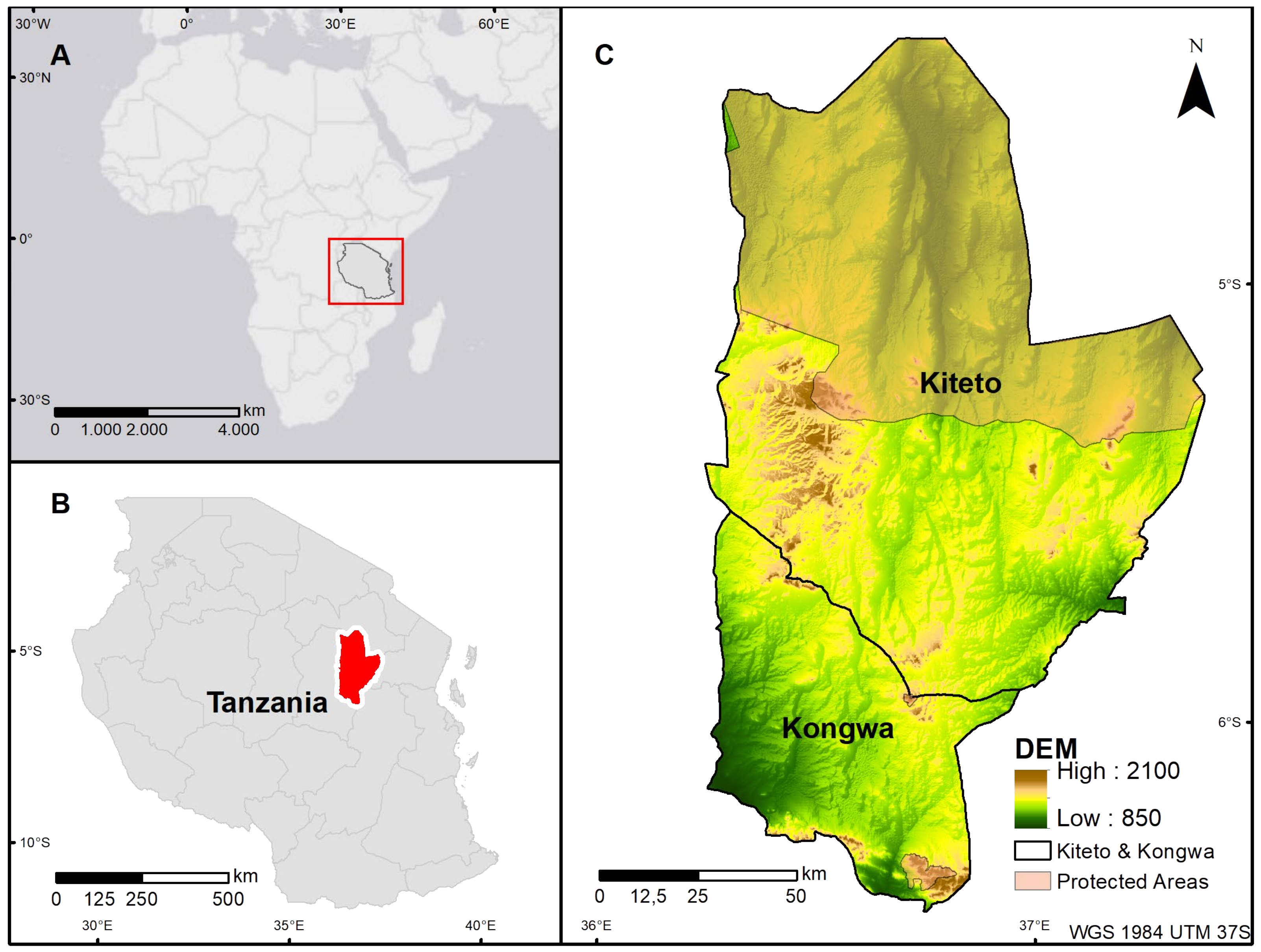
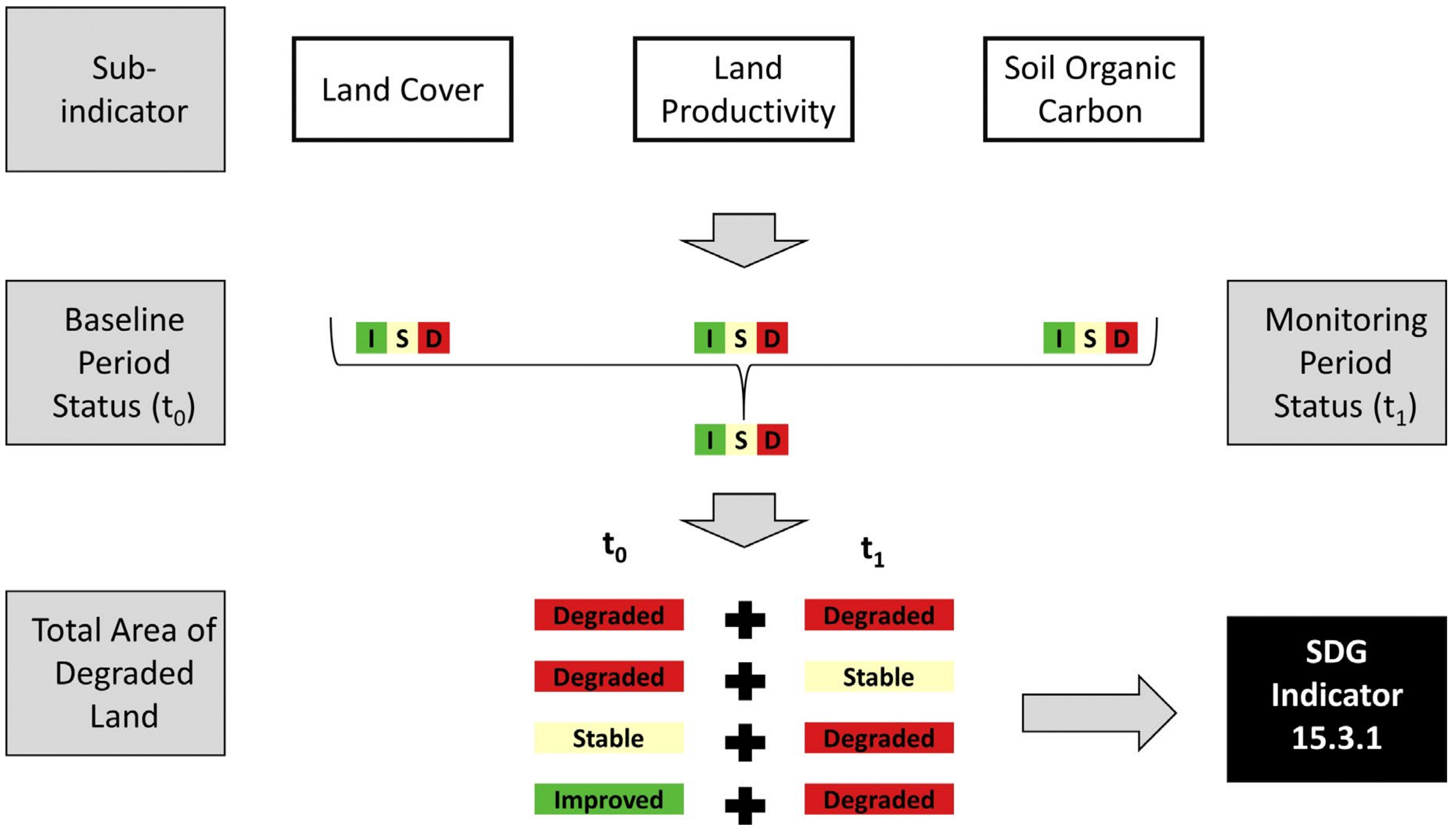
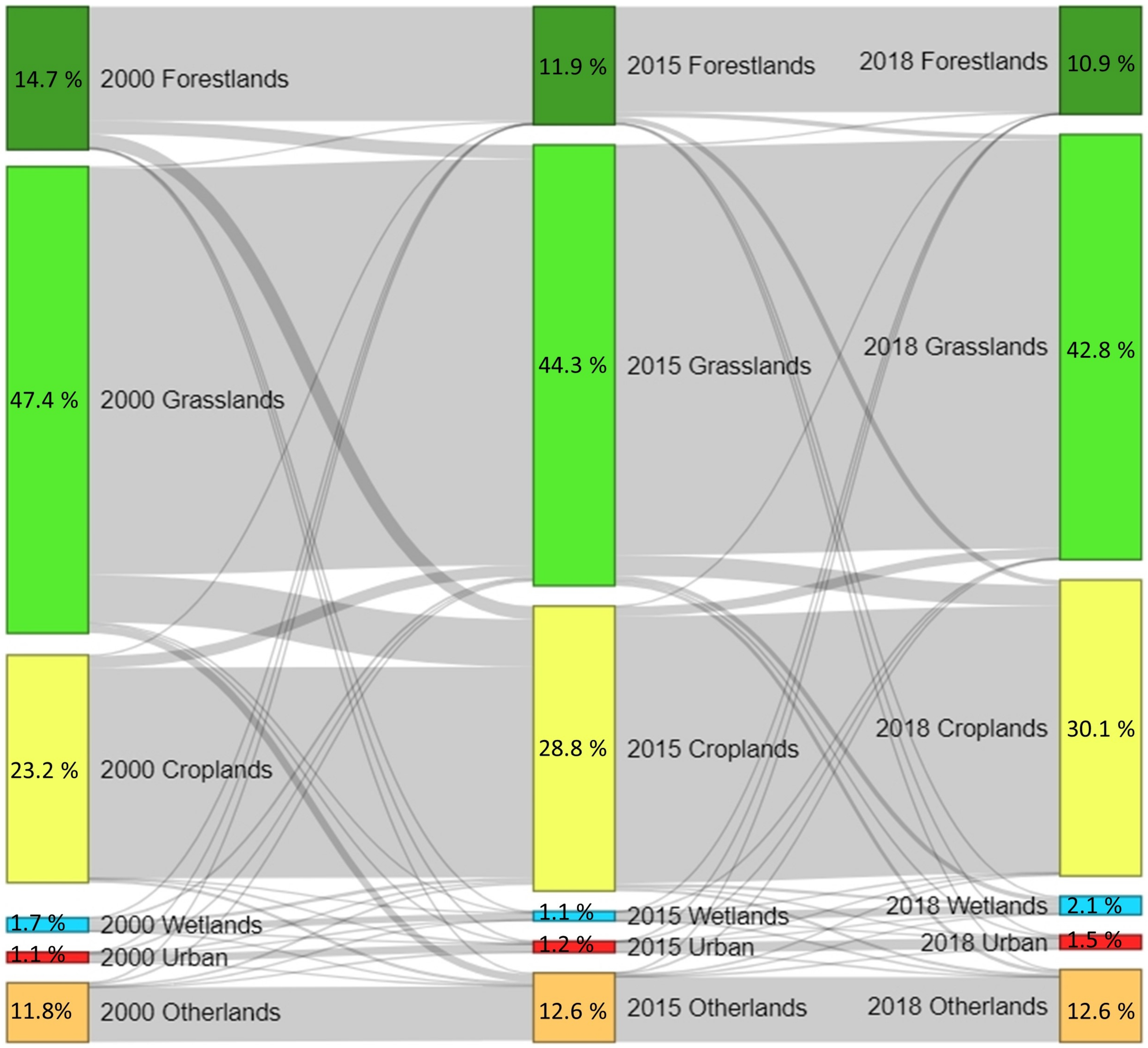
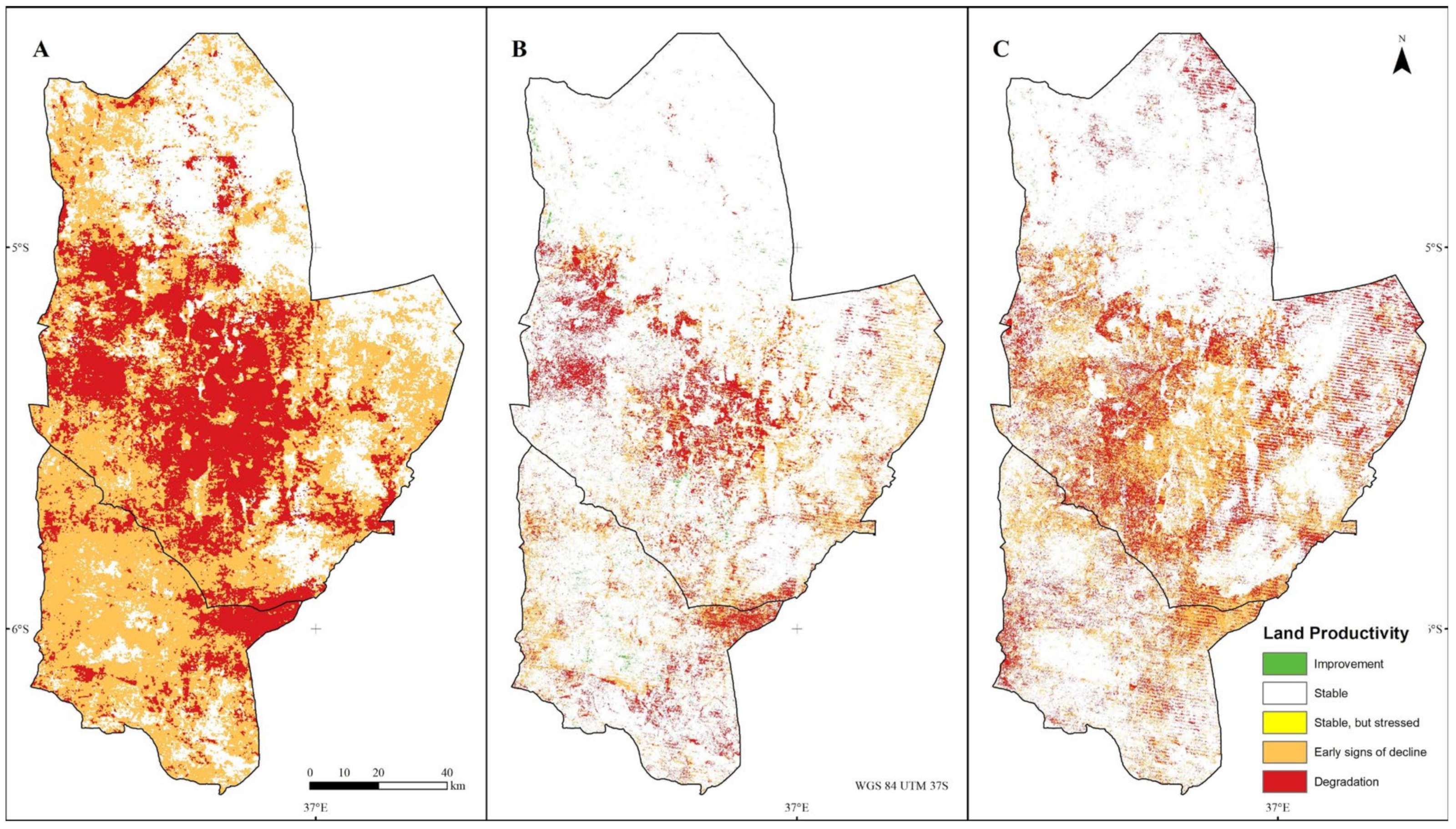

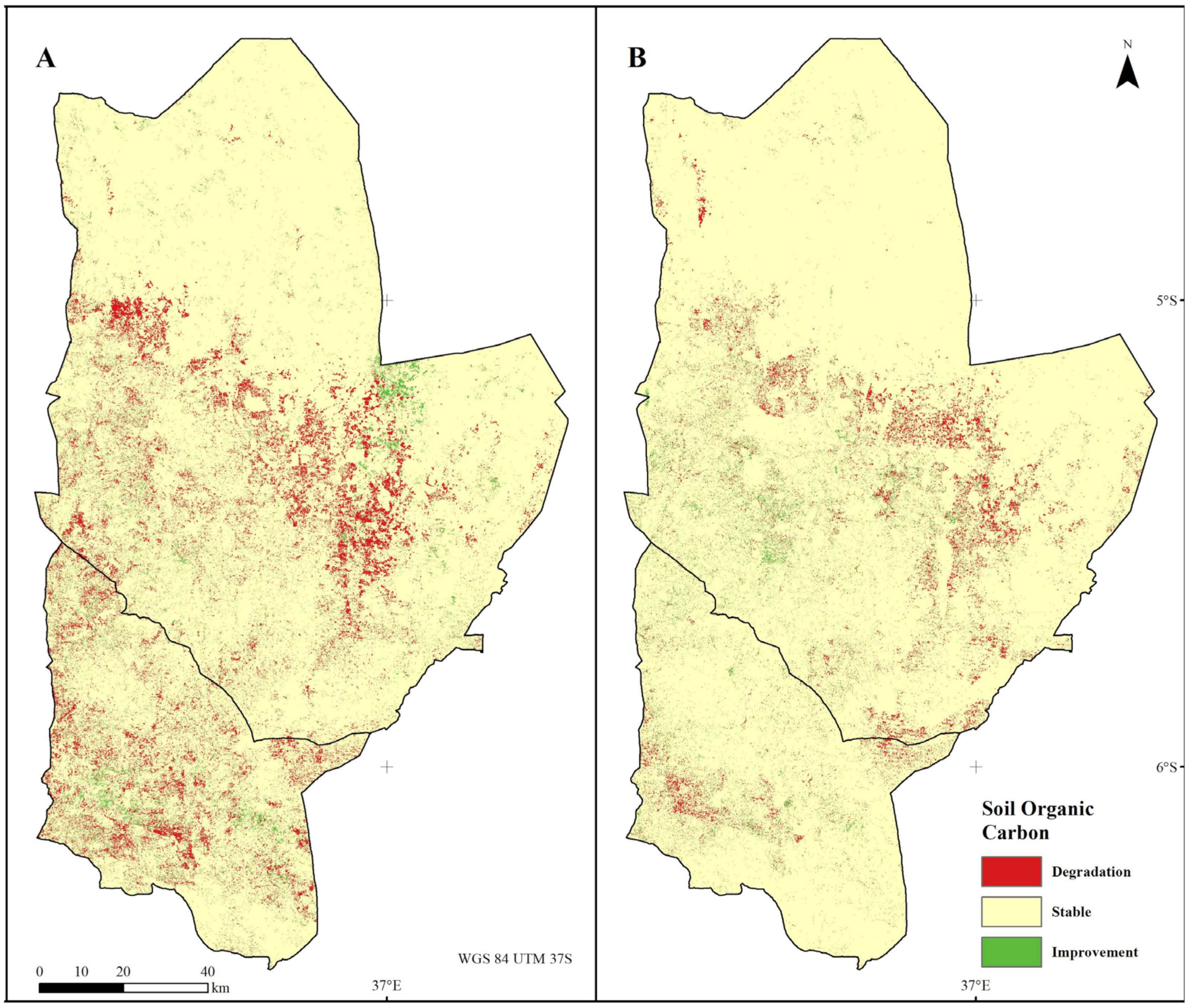
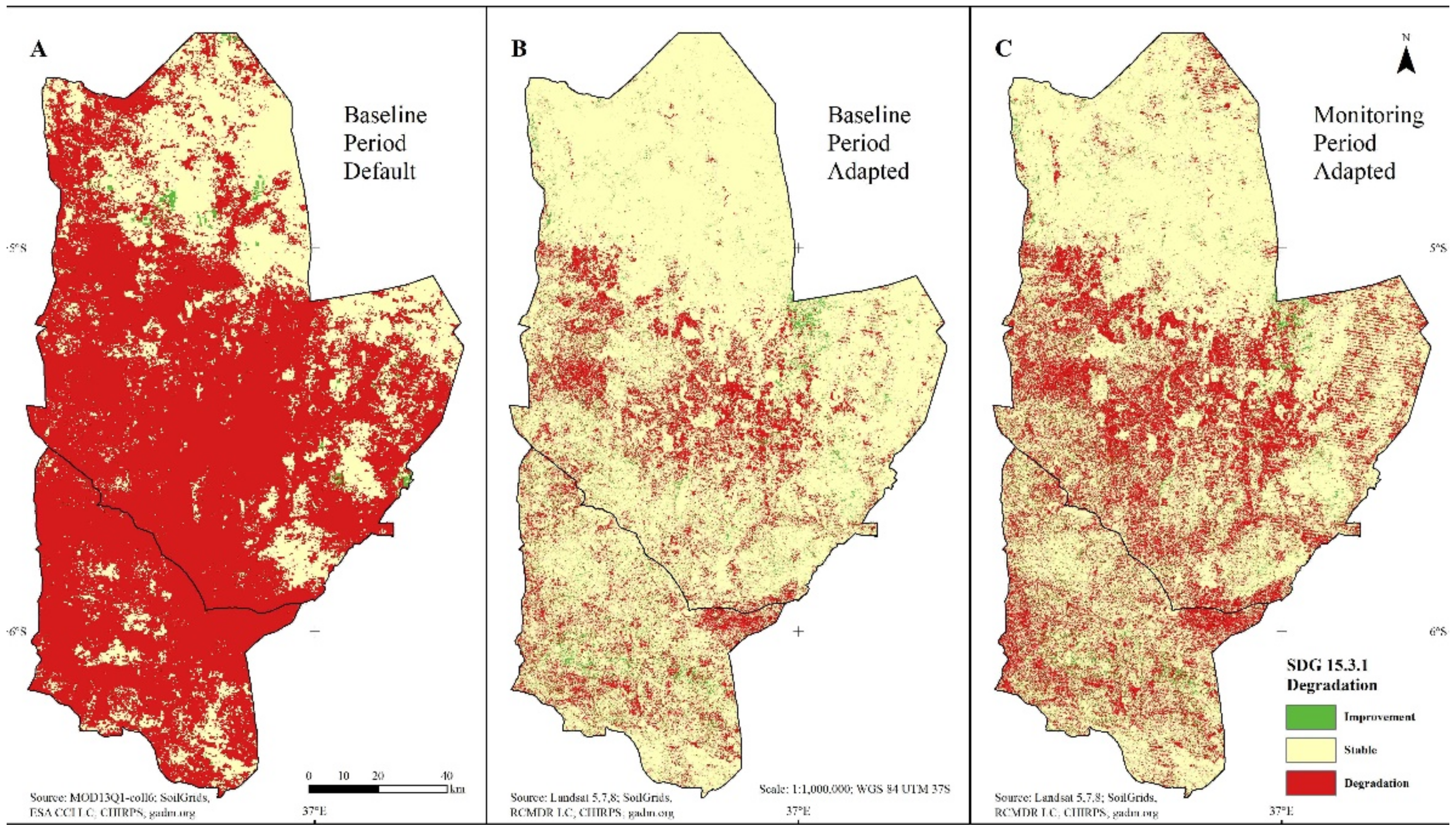

| AM Land Cover Category in 2015 (km2) | 2000 Total (km2) | |||||||
|---|---|---|---|---|---|---|---|---|
| Forestland | Grassland | Cropland | Wetland | Urban | Otherland | |||
| AM land cover category in 2000 (km2) | Forestland | Stable 1969.4 | Vegetation loss 226.8 | Deforestation 237.5 | Inundation 9.2 | Deforestation 3 | Vegetation loss 72.7 | 2519 |
| Grassland | Afforestation 36 | Stable 6932.4 | Agricultural expansion 806 | Inundation 26.4 | Urban expansion 40.4 | Vegetation loss 253.5 | 8094.6 | |
| Cropland | Afforestation 24.1 | Withdrawal of agriculture 221.8 | Stable 3622.3 | Inundation 10.3 | Urban expansion 14.7 | Vegetation loss 76.2 | 3969.3 | |
| Wetland | Woody encroachment 3.1 | Waterbody drainage 53.4 | Waterbody drainage 77.3 | Stable 131.4 | Waterbody drainage 3.4 | Waterbody drainage 28.5 | 297.1 | |
| Urban | Afforestation 0.4 | Vegetation establishment 11.4 | Agricultural expansion 32.8 | Wetland establishment 0.5 | Stable 141.5 | Withdrawal of settlements 7.3 | 193.8 | |
| Otherland | Afforestation 7.6 | Vegetation establishment 118.2 | Agricultural expansion 149.7 | Wetland establishment 15.1 | Urban expansion 8.1 | Stable 1718.9 | 2017.5 | |
| 2015 total (km2) | 2041 | 7563.9 | 4925.6 | 192.9 | 211 | 2157 | 17,091.4 | |
| DM 2000–2015 | AM 2000–2015 | AM 2015–2019 | ||
|---|---|---|---|---|
| LP Status (%) | Degraded | 71.1 | 8.2 | 12.2 |
| Stable | 28.9 | 91.3 | 87.7 | |
| Improved | 0 | 0.5 | 0.1 |
| DM SOC | AM SOC | AM SOC | ||||
|---|---|---|---|---|---|---|
| 2000 | 2015 | 2000 | 2015 | 2018 | ||
| Status (%) | Degraded | 0.1 | 8.1 | 3.7 | ||
| Stable | 99.9 | 90 | 94.7 | |||
| Improved | 0 | 2 | 1.7 | |||
| SOC (t/ha) | Study area | 51.2 | 51.2 | 51.2 | 50.2 | 49.9 |
| Forestland | 54.7 | 54.7 | 63.2 | 62.2 | 62 | |
| Grassland | 55 | 55 | 50.7 | 49.7 | 49.5 | |
| Cropland | 46.2 | 46.2 | 46.5 | 46.9 | 46.9 | |
| Wetland | 45.1 | 45.1 | 49.2 | 47 | 46.7 | |
| Urban | 36.2 | 36.2 | 39.5 | 42.8 | 42.8 | |
| Otherland | 0 | 0 | 46.2 | 47.6 | 47.6 | |
Publisher’s Note: MDPI stays neutral with regard to jurisdictional claims in published maps and institutional affiliations. |
© 2021 by the authors. Licensee MDPI, Basel, Switzerland. This article is an open access article distributed under the terms and conditions of the Creative Commons Attribution (CC BY) license (https://creativecommons.org/licenses/by/4.0/).
Share and Cite
Reith, J.; Ghazaryan, G.; Muthoni, F.; Dubovyk, O. Assessment of Land Degradation in Semiarid Tanzania—Using Multiscale Remote Sensing Datasets to Support Sustainable Development Goal 15.3. Remote Sens. 2021, 13, 1754. https://doi.org/10.3390/rs13091754
Reith J, Ghazaryan G, Muthoni F, Dubovyk O. Assessment of Land Degradation in Semiarid Tanzania—Using Multiscale Remote Sensing Datasets to Support Sustainable Development Goal 15.3. Remote Sensing. 2021; 13(9):1754. https://doi.org/10.3390/rs13091754
Chicago/Turabian StyleReith, Jonathan, Gohar Ghazaryan, Francis Muthoni, and Olena Dubovyk. 2021. "Assessment of Land Degradation in Semiarid Tanzania—Using Multiscale Remote Sensing Datasets to Support Sustainable Development Goal 15.3" Remote Sensing 13, no. 9: 1754. https://doi.org/10.3390/rs13091754
APA StyleReith, J., Ghazaryan, G., Muthoni, F., & Dubovyk, O. (2021). Assessment of Land Degradation in Semiarid Tanzania—Using Multiscale Remote Sensing Datasets to Support Sustainable Development Goal 15.3. Remote Sensing, 13(9), 1754. https://doi.org/10.3390/rs13091754





